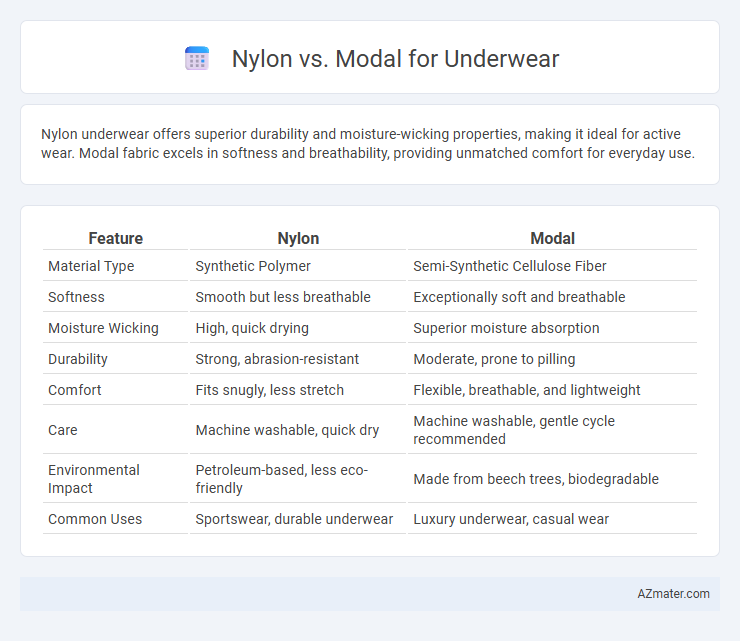Nylon underwear offers superior durability and moisture-wicking properties, making it ideal for active wear. Modal fabric excels in softness and breathability, providing unmatched comfort for everyday use.
Table of Comparison
| Feature | Nylon | Modal |
|---|---|---|
| Material Type | Synthetic Polymer | Semi-Synthetic Cellulose Fiber |
| Softness | Smooth but less breathable | Exceptionally soft and breathable |
| Moisture Wicking | High, quick drying | Superior moisture absorption |
| Durability | Strong, abrasion-resistant | Moderate, prone to pilling |
| Comfort | Fits snugly, less stretch | Flexible, breathable, and lightweight |
| Care | Machine washable, quick dry | Machine washable, gentle cycle recommended |
| Environmental Impact | Petroleum-based, less eco-friendly | Made from beech trees, biodegradable |
| Common Uses | Sportswear, durable underwear | Luxury underwear, casual wear |
Introduction to Nylon and Modal Fabrics
Nylon is a synthetic fabric known for its high durability, elasticity, and moisture-wicking properties, making it a popular choice for underwear that requires long-lasting comfort and shape retention. Modal, a semi-synthetic fiber derived from beech tree pulp, offers exceptional softness, breathability, and excellent moisture absorption, providing a naturally smooth feel ideal for sensitive skin. Both fabrics excel in different performance areas, with nylon emphasizing strength and stretch, while modal prioritizes softness and eco-friendliness in underwear applications.
Fabric Composition: Nylon vs Modal
Nylon underwear is crafted from synthetic polyamides known for their durability, elasticity, and moisture-wicking properties, making them ideal for activewear. Modal fabric, derived from beech tree cellulose, offers a natural, breathable, and silky-soft texture with excellent moisture absorption, enhancing comfort for sensitive skin. Both fabrics differ significantly in fiber origin--synthetic nylon versus semi-synthetic modal--impacting their softness, breathability, and environmental footprint in underwear applications.
Softness and Comfort Comparison
Modal fabric offers superior softness due to its semi-synthetic cellulose fibers, providing a smooth, breathable texture ideal for underwear comfort. Nylon, while durable and moisture-wicking, tends to be less breathable and can feel less soft against the skin compared to modal. For optimal underwear softness and comfort, modal fabric outperforms nylon by delivering a gentle, lightweight feel with better moisture absorption.
Moisture-Wicking and Breathability
Nylon offers excellent moisture-wicking properties, efficiently drawing sweat away from the skin to keep underwear dry and comfortable during active use. Modal, a semi-synthetic fabric made from beech tree pulp, provides superior breathability and a soft, smooth texture that enhances comfort for sensitive skin. Combining moisture management and airflow, Modal tends to outperform Nylon in breathability, while Nylon excels in durability and faster drying times.
Durability and Longevity
Nylon offers exceptional durability due to its strong synthetic fibers, making it highly resistant to wear and tear, stretching, and abrasion, which extends the longevity of underwear. Modal, a semi-synthetic fiber derived from beech tree pulp, is softer and more breathable but tends to be less durable, prone to pilling and fading over time with frequent washing. For underwear prioritizing extended lifespan and resilience, nylon is often the preferred choice, while modal excels in comfort and moisture management.
Stretch and Fit Performance
Nylon offers exceptional stretch and recovery, providing underwear with a snug yet flexible fit that adapts to body movements without losing shape. Modal fabric, known for its softness, also delivers good stretch but emphasizes comfort and breathability over maximum elasticity. For optimal fit performance in underwear, nylon's superior resilience ensures durability and long-lasting shape retention during wear.
Odor Resistance and Hygiene
Nylon offers moderate odor resistance but tends to retain moisture, which can promote bacterial growth and reduce hygiene over time. Modal excels in moisture-wicking and breathability, significantly reducing odor buildup and enhancing overall hygiene for underwear. Choosing modal fabric can improve freshness and comfort during prolonged wear due to its natural resistance to bacteria and better moisture management.
Skin Sensitivity: Allergies and Irritation
Modal fabric is highly recommended for underwear due to its hypoallergenic properties, making it ideal for sensitive skin and reducing the risk of allergies and irritation. Nylon, while durable and moisture-wicking, can sometimes cause skin irritation and allergic reactions in individuals with sensitive skin. Choosing modal underwear helps maintain skin comfort and prevents common issues like itching, redness, or rashes associated with synthetic fibers like nylon.
Eco-Friendliness and Sustainability
Modal, made from beech tree pulp, is more eco-friendly and sustainable than conventional Nylon, which is derived from non-renewable petroleum resources. Modal production uses less water and energy, is biodegradable, and often sourced from sustainably managed forests, whereas Nylon manufacturing involves significant greenhouse gas emissions and long-lasting microplastic pollution. Choosing Modal underwear supports reduced environmental impact and aligns with sustainable fashion initiatives.
Final Verdict: Choosing the Best Fabric for Underwear
Modal offers superior breathability and moisture-wicking properties, making it ideal for underwear that prioritizes comfort and skin health. Nylon provides exceptional durability and stretch, ensuring a snug fit and long-lasting wear under various conditions. Choosing between nylon and modal depends on whether you value softness and breathability (modal) or strength and elasticity (nylon) for your underwear needs.

Infographic: Nylon vs Modal for Underwear
 azmater.com
azmater.com